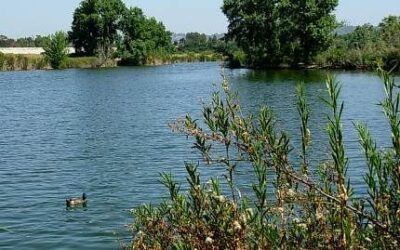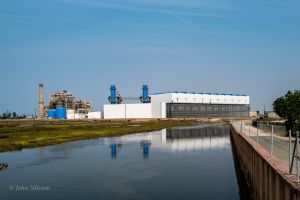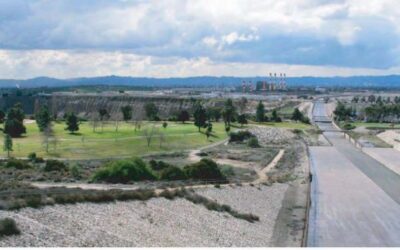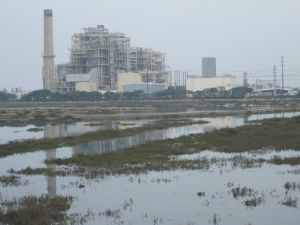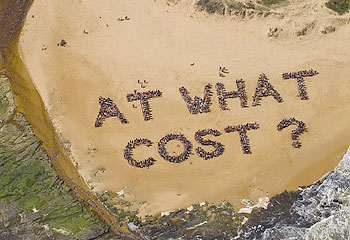Ocean Desalination
View OCEAN DESALINATION BLOG Posts
The Problem with Poseidon (Source: California Desal Facts)
Sierra Club strongly advocates that agencies should encourage water use efficiency projects in preference to all types of water supply projects, including desalination. Desalination, particularly ocean desalination should be the last resort after water conservation, water reuse and improvements in aging water infrastructure projects have been exhausted.
Whales © Elianne Dipp
Ocean Desalination Facts
- Ocean desalination costs more than any other option
- Ocean desalination uses more energy than any other option–which means bigger contributions to global warming
- Desalination technology can kill marine life
- Desalination creates water pollution
- Desalination can fail to remove harmful chemicals from your drinking water
- Desalination projects invite corporate abuse of your public water systems
- Desalination is not necessary – we have other alternatives. Conservation programs are cheaper and without the risks of desalination. They are not as profitable for private companies but they better serve the public.
Some elected officials get taken in by industry’s claims. Catalina Island is performing sea water desalination but only on a small scale; it would not be the same for the City of Los Angeles. The majority of existing desalination plants in the United States desalt brackish river or ground water, not ocean water, and usually for very small-scale industrial purposes. Desalination shouldn’t be used as a quick fix to our water shortage problems.
Conservation and recycling programs may be a much less expensive and less risky alternative to building desalination plants. For example, our nation’s water systems lose 6 billion gallons of water per day due to problems such as leaking pipes. Utilities cannot account for this water because many do not have the resources to implement comprehensive leak monitoring programs. It would be more cost-effective to concentrate on eliminating these leak problems. Desalination could create more problems than it solves.
Environmental & Health Issues: Ocean water desalination can be greater than ten times more energy intensive than other options. According to the U.S. Environmental Protection Agency, water intake structures on power plants, which are very similar to planned desalination intakes, kill at least 3.4 billion fish and other marine organisms annually. This can result in a loss of millions of dollars of fishing revenue.
Opposition to the Poseidon facility
The Defeat of Brookfield-Poseidon Huntington Beach Ocean Desalination Project
Poseidon Water Desalination Plant, Huntington Beach, CA.
@2024 Raymond Hiemstra, All Rights Reserved
Opposition to the Poseidon facility
Ocean Desalination Campaign
Poseidon is facing opposition by environmental groups over its proposed plans to build another facility in Huntington Beach. The company has received several permits for the Orange County project, but still needs approval from the Coastal Commission.
A large well-known company made a commercial that shows a boat load of rugged fishermen pulling blocks of bottled water from the sea, as if they were fish, and celebrating their new pure, fresh source of water. Such marketing makes ocean desalination appear simple and easy. It is not. In reality, it involves huge plants, heavy machinery, lots of energy and extremely high financial, social and environmental costs. They promise that reverse osmosis technology can turn the ocean into a reliable source of drinking water by removing the salt from seawater. While they offer their product for two to four times the cost of other water sources, they fail to advertise the toxic chemicals, marine life damage, carbon emissions and other social and environmental ills that come along with it.
Poseidon Water Desalination Plant, Huntington Beach, CA.
@2021 John Nilsson, All Rights Reserved
SIGN A PETITION
Add your voice and signature to these Sierra Club AddUp campaigns:
Ocean shore. ©Kyriakos Kinatidis, All Rights Reserved.
Environmental and Health Issues
A number of public health experts have expressed concern that new contaminants not present in normal drinking water could end up in our glass. Contaminants such as boron, algal toxins (for example, red tide) and endocrine disrupters might be found in ocean water and are concentrated through the desalination process. Since at times the oceans have been used as dumping grounds, anything can show up in the drinking water, such as unwanted/unregulated chemicals, pharmaceuticals, personal care products & others. Then, only a portion of the ocean water that enters the plant actually reaches the consumer. The remaining water ends up as a highly concentrated solution that contains both the salt from the ocean and an array of chemicals from the industrial process – which is released right back into the ocean, toxins and all.
Southern California Water Systems
What are Some Desalination Issues on the California Coastline?
Some coastline communities from all over the world have been desalinating their water. Such diverse countries as Australia, Spain, Singapore, Saudi Arabia & the other Gulf States have used this technique. Israel has just approved its fifth desalination (desal) plant and they are hoping that it will provide 75% of its drinking water by 2013. Along the Pacific Coast of CA there are now 17 proposals for desal facilities. SFgate.com says, “But many projects have been stymied by skyrocketing construction costs, huge energy requirements for running plants, regulatory delays and legal challenges over environmental impacts on marine life.” There are different techniques to de-salt water. Reverse osmosis is a popular technique and so is the practice of pushing ocean or brackish water through a salt-removing membrane filter at high pressure. Both of these practices are energy intensive because pumps are used to move tremendous amounts of water through the membranes. When possible it is cheaper to emphasize conservation like low-flow toilets and stricter zoning laws that require less water-intensive landscaping. These practices have decreased demand throughout CA. SFgate.com says, “Desalination plants can take water from the ocean or drill down and grab the less salty, brackish water from seaside aquifers. Because of their potential impacts to marine life, the California Coastal Commission reviews each project case-by-case.”
In Northern & Central California: As of Oct. 2012 there is only one small desal plant operating to create drinking water on the main California coastline and that one is at a former military base turned into an artsy seaside destination named Sand City, on Monterey Bay. According to SFgate.com,”The $14 million facility has the ability to produce up to 600,000 gallons a day of drinkable water for the town of about 340 people. Sand City’s plant now produces half that amount each day; a third is used by the city with the rest sent elsewhere in Monterey County.” Sand City had no possibility to acquire water so they turned to desalination because they wanted to develop the area. Nearby is another $7million desal plant in the town of Marina that has been closed because rising energy costs made the plant too expensive but they do see a day when the need for water will be so great that they will run the plant again. They are even planning another larger plant. SFgate says, “(Desal) Proposals have been fraught with mistakes, political infighting and scandal, and have cost Monterey area ratepayers tens of millions of dollars.” In Northern CA, the wealthy Marin County has been planning a desalination plant for 2 decades and they have spent millions on a pilot facility but now they have decided to discontinue their plans. Libby Pischel of the Marin Municpal Water District said, “We found that our demand for water had dropped so much since the time we started exploring desalination, we didn’t need the water.” “Right now, conservation costs less than desalination.”
What is happening in So. California: SFgate.com says, “There was great fanfare in 2009 when the last regulatory hurdle was cleared to build the Western Hemisphere’s largest desalination plant in Carlsbad, north of San Diego. At the time, it was proposed that the $320 million project would suck in 100 million gallons of seawater and be capable of producing 50 million gallons of drinking water a day. It was expected to come online by 2012.”. Since then, the plant owner, Poseidon Resources LLC, has been negotiating a water purchase agreement and is close to clinching a 30-year deal with the San Diego County Water Authority, a wholesaler to cities and agencies that provide water to 3.1 million people. The compact is essential for Poseidon to obtain financing to build what has become a $900 million project, which includes the seaside plant and a 10-mile pipeline. The San Diego agency hopes the plant opens in 2016 and anticipates desalination will account for 7 percent of the region’s supply in 2020. It estimates the cost is comparable to other new, local sources of drinking water, such as treated toilet water or briny groundwater.”

Image by David Ledig for the Bureau of Land Management.
[Top header image of seal © Elianne_Dipp, All Rights Reserved]
Ocean Desalination Posts
Permits First
Posted on 3 May 2021 By Randy Kokal You need a hunting license before you go hunting, a marriage license before you get married and the Poseidon desalination project needs to get their permits before they are allowed to operate. Poseidon has asserted (with no...
Ocean Desalination Meets Homelessness?
Posted on 23 February 2021 By Charming Evelyn - Chair, Water Committee Who would think it? Ocean desalination intersecting with affordable housing?- Yet it has, in a little known state government agency called the California Debt Limit Allocation Committee (CDLAC)....
Poseidon’s Toxic Desalination Proposal
The people behind the Poseidon project feel Orange County residents do not pay enough for water. They feel that residents can and should pay. They see a potential profit in each glass of water, each shower and each toilet flush. Their plan is simple, add more...
Orange County: Waste, Water and Energy
Posted on 8 January 2021 By Hoiyin Ip pv>One of my favorite quotes over the years is by Gloria Steinem: "In each of these stages of campaigning, I've been inspired, angry, hopeless, hopeful, sleepless, surprised, betrayed, exhausted, educated, energized, despairing,...
Goodbye, Oil: US Navy Cracks New Renewable Energy Technology To Turn Seawater Into Fuel, Allowing Ships To Stay At Sea Longer
Goodbye, Oil: US Navy Cracks New Renewable Energy Technology To Turn Seawater Into Fuel, Allowing Ships To Stay At Sea Longer. See report in the International Business Times. Photo source The River Project
Action Alert: Oppose the Poseidon Huntington Beach Desalination Plant
Posted on 2 May 2013 By jrobinson As you may be aware the Sierra Club has taken a strong position opposing the Poseidon Huntington Beach Desalination Plant due to its destructive impacts on ocean water quality and climate change. There is a critical vote coming up...
Desalination destroys the environment and isn’t a quick fix for Southern California’s water woes
Posted on 4 March 2013 By By Ray Hiemstra Many people in Southern California think that we are in a perpetual drought and will not have enough water to sustain ourselves. Unfortunately, this common fear is fueling misguided support for ocean desalination, the process...

